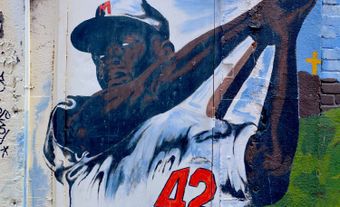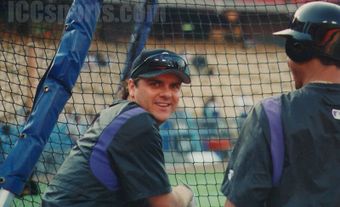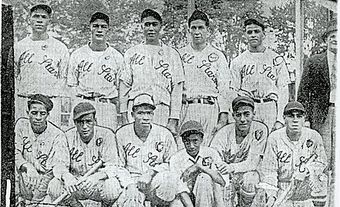Ferguson “Fergie” Arthur Jenkins, CM, baseball player (born 13 December 1942 in Chatham, ON). Fergie Jenkins is widely regarded as Canada’s greatest baseball player. The 6-foot-5 right-hander employed pinpoint control to become one of the game’s most dominant pitchers. He won the National League Cy Young Award as the league’s top pitcher in 1971 and was a three-time All-Star. He won the Lionel Conacher Award as Canada’s male athlete of the year four times and the Lou Marsh Award (now Northern Star Award) as the country’s top athlete in 1974. In 1991, Jenkins became the first Canadian to be inducted into the Baseball Hall of Fame. He has also been inducted into the Canadian Baseball Hall of Fame, Canada’s Sports Hall of Fame and Canada’s Walk of Fame. His No. 31 has been retired by the Chicago Cubs, who erected a statue in his honour in 2022.

Early Life
Fergie Jenkins is the only child of Delores Jackson and Ferguson Jenkins, Sr. His mother’s ancestors emigrated to Canada from the Southern United States via the Underground Railroad and settled in Chatham, Ontario. His father was a speedy outfielder who came to Southwestern Ontario during the Great Depression to play semi-professional baseball. He started out in Windsor but eventually played centre field for the Chatham Colored All-Stars, the first all-Black team to win an Ontario Baseball Amateur Association (OBAA) championship.
As a youngster in Chatham, Jenkins grew to 6-foot-5. He was a star on his high school basketball team and a sturdy defenceman on his minor hockey teams. He was also a standout first baseman in the local minor baseball ranks. He did not pitch until he was 16, but it was quickly evident how strong his arm was. He had strengthened it by throwing stones through the open doors of boxcars that passed near his home.
In 1959, high school teacher Gerry McCaffery was so impressed with Jenkins’s skills that he summoned Philadelphia Phillies scout and fellow teacher Gene Dziadura to come and have a look. Dziadura, who hailed from Windsor and had played three seasons in the Chicago Cubs organization, was wowed by Jenkins’s arm. He sent a report about the young right-hander to the Phillies. Shortly thereafter, Dziadura began teaching at Chatham Collegiate Institute and working with Jenkins a few nights a week. Under Dziadura’s tutelage, Jenkins developed into a dominant local pitcher. On 15 June 1962, he signed with the Phillies as an amateur free agent.
Minor League Career
Fergie Jenkins reported to the Phillies’ Class-D Miami Marlins in 1962. It was there that he encountered large-scale racism and segregation for the first time. But that did not stop him from excelling on the field. In his first professional season, he posted a 7–2 record and a 0.97 ERA in 11 appearances and was promoted to the Triple-A Buffalo Bisons.
He returned to Miami in 1963 and recorded 12 wins in 20 games. He then amassed 15 victories in 32 combined outings between Double-A Chattanooga and Triple-A Arkansas the following year.
Jenkins possessed a resilient arm, but his arsenal was not overpowering. The Phillies thought his future was as a relief pitcher. They used him primarily in that capacity with Triple-A Arkansas in 1965; his 2.95 ERA in 122 innings was enough to convince the Phillies to call him up.
Philadelphia Phillies (1965–66)
Fergie Jenkins made his Major League debut on 10 September 1965 against the St. Louis Cardinals at Connie Mack Stadium. He relieved right-hander Jim Bunning in the eighth inning with the score tied and pitched 4.1 scoreless innings to earn the win in the Phillies’ 5–4, 12-inning victory.
Jenkins made six more relief appearances for the Phillies that September and another the following April. However, manager Gene Mauch didn’t believe that the young right-hander had the fastball to be a big-league starter. On 21 April 1966, the Phillies — a team that had a long, sordid history of troubled relationships with its Black players — traded Jenkins, Adolfo Phillips and John Herrnstein to the Chicago Cubs for veteran starting pitchers Larry Jackson and Bob Buhl.
Chicago Cubs (1966–73)
The Cubs initially employed Fergie Jenkins as a reliever until they moved him into their starting rotation on 25 August 1966. Jenkins made nine starts to close the season and impressed enough to start on Opening Day for the Cubs in 1967. From there, he blossomed into the Cubs’ ace. His strong first-half earned him a selection to the All-Star Game, where he tied a Midsummer Classic record with six strikeouts in three innings in relief. He completed that campaign with a 20–13 record and a 2.80 ERA with 20 complete games in 38 starts. That was the first of six consecutive 20-win seasons with the Cubs. He finished second in the National League Cy Young Award voting that year.
In 1968, the Canadian ace again won 20 games while posting an even lower ERA of 2.63. The following season, the Cubs, propelled by another 20-win performance by Jenkins, were in first place in the National League East division until 9 September before they were overtaken by the New York Mets. Jenkins set a career high with 42 starts and topped the National League with 273 strikeouts — the only time he led the league in strikeouts.
Though not a flame-thrower like Sandy Koufax or Nolan Ryan, Jenkins excelled at using pinpoint control to get hitters out. He was also remarkably durable; he not only routinely pitched complete games but did so at a time when National League pitchers still took at-bats. He reportedly never had a sore arm during his big-league career.
"What Jenkins did was very simple: he threw the ball down and away. That was it. That was the whole thing. He pitched and lived with a singular focus that was in and of itself a superpower. If he struck out a hitter, his next pitch was down and away. Allowed a home run? Down and away. Men on base? Down and away. No-hitter going? Down and away. He never wavered and never backed down and never saw anything but that one portion of the plate. Ferguson Jenkins hit more corners than sunlight … [He] threw fastballs — four-seamers, two-seamers — and with each pitch, he sent a message:'This is the best I got. If you can beat me, beat me. But I like my chances.'" — Joe Posnanski in The Athletic, 6 January 2020
Jenkins’s success continued in 1970, when he recorded 22 wins and topped the National League with 24 complete games. This set the stage for his outstanding 1971 campaign in which he led NL pitchers with 24 wins, 30 complete games and 325 innings pitched. He also recorded 14 extra-base hits, including six home runs, in the 39 games he played, finishing the year with a slash line of .243/.282/.478. Jenkins became the first (and remains the only) Canadian to win the National League Cy Young Award.
Jenkins followed that up with his sixth consecutive 20-win season in 1972 — a feat that no major league pitcher has accomplished since. That streak ended when his win total dropped to 14 while pitching just seven complete games in 1973.
Texas Rangers (1974)
After the 1973 season, some in the Chicago Cubs organization felt that Fergie Jenkins, about to turn 30, was in decline. He was traded to the Texas Rangers on 25 October 1973.
The Rangers had finished in last place in 1973, but with Jenkins as their ace the club improved dramatically. Jenkins registered a career-high 25 wins and led the American League with 29 complete games to propel the Rangers to second place in their division. For his efforts, Jenkins finished second in American League Cy Young voting and was named The Sporting News Comeback Player of the Year.
But the magic for Jenkins and the Rangers wore off in 1975. He registered 17 wins but also had 18 losses and his ERA increased to 3.93.
Boston Red Sox (1975–77)
In a cost-cutting move, the Rangers dealt Fergie Jenkins to the reigning American League champion Boston Red Sox on 17 November 1975. Jenkins managed 12 wins in 1976 before he tore his right Achilles tendon while covering first base on 1 September. The Red Sox finished third in their division.
Though the Sox improved to a 97–64 record in 1977, Jenkins clashed with manager Don Zimmer and completed the season with a 10–10 record and a 3.68 ERA. On 14 December 1977, Jenkins was traded back to the Rangers.
Texas Rangers (1977–81)
A 35-year-old Fergie Jenkins rediscovered his form with the Rangers in 1978, winning 18 games and registering a 3.04 ERA. That was the peak of his second tenure with Texas, which lasted four seasons. He collected 16 victories for the Rangers in 1979 before his win totals fell to 12 and five in the ensuing two seasons.
Chicago Cubs (1982–84)
On 8 December 1981, just prior to his 39th birthday, Fergie Jenkins re-signed with the Chicago Cubs. He looked rejuvenated in his first season back, earning 14 wins while tossing 217 innings. But time caught up with him the following year when his record fell to 6–9 in 33 games. Jenkins went to spring training with the Cubs in 1984 but was released. He then returned to his farm in Blenheim, Ontario.
Major League Totals
Fergie Jenkins concluded his career with 284 wins, a now-unheard-of 267 complete games, and 3,192 strikeouts — all records for a Canadian in Major League Baseball. At the time of his retirement, Jenkins was the only pitcher in MLB history to amass more than 3,000 strikeouts while walking fewer than 1,000 batters. (Only three others — Curt Schilling, Greg Maddux and Pedro Martinez — have done so since then, in an era when strikeouts became far more common.) Jenkins won 20 games in a season seven times and has the fifth most putouts by a pitcher in Major League history (363).
Coaching Career
In 1987, Fergie Jenkins served as a coach for the Canadian national baseball team. The following year, he was hired as pitching coach of the Triple-A Oklahoma 89ers. After two years in that role, he became the minor league pitching coordinator for the Cincinnati Reds. In 1995 and 1996, Jenkins served as the Chicago Cubs’ pitching coach.
Baseball Hall of Fame
In 1991, in his third year of eligibility, Fergie Jenkins was elected to the Baseball Hall of Fame in Cooperstown by the Baseball Writers’ Association of America. He became the first Canadian to be so honoured.
Other Activities
Fergie Jenkins played for the Harlem Globetrotters during the off-seasons in 1967, 1968 and 1969. He also ran as a Liberal Party candidate in the riding of Windsor-Riverside in the 1985 Ontario election but finished third with 4,418 votes.
Personal Life
Fergie Jenkins has endured several personal tragedies. As he once said, “In my life, I’ve been a part of many funerals.” Just four days after he learned he had been elected to the Baseball Hall of Fame, his second wife died. Less than two years after that, his girlfriend took her own life and that of Jenkins's three-year-old daughter, Samantha, via carbon monoxide poisoning.
Jenkins has three daughters, Kimberly, Kelly and Delores, and one stepson, Raymond. He currently resides in Frisco, Texas, but much of his family has remained in Chatham, Ontario.
Honours
In 2011, Canada Post issued a stamp in honour of Fergie Jenkins as part of its Black History Month series. It was in circulation until 2023.
Jenkins’s No. 31 was retired by the Chicago Cubs in 2009. In 2022, the club erected a statue of Jenkins outside Wrigley Field in Chicago. The Cubs also gifted a replica of the statue to the city of Chatham-Kent, where it was erected in front of the civic centre in 2023.
Awards
- Lionel Conacher Award, Canadian Press Male Athlete of the Year (1967, 1968, 1971, 1974)
- National League Cy Young Award (1971)
- Lou Marsh Trophy (now Northern Star Award) (1974)
- American League Comeback Player of the Year Award, The Sporting News (1974)
- Member, Order of Canada (1979)
- Inductee, Canadian Baseball Hall of Fame and Museum (1987)
- Inductee, Canada’s Sports Hall of Fame (1987)
- Inductee, Canada’s Walk of Fame (2001)
See also Canadian Baseball Hall of Fame; Canada’s Sports Hall of Fame; Canada’s Forgotten Baseball History; Larry Walker.

 Share on Facebook
Share on Facebook Share on X
Share on X Share by Email
Share by Email Share on Google Classroom
Share on Google Classroom





